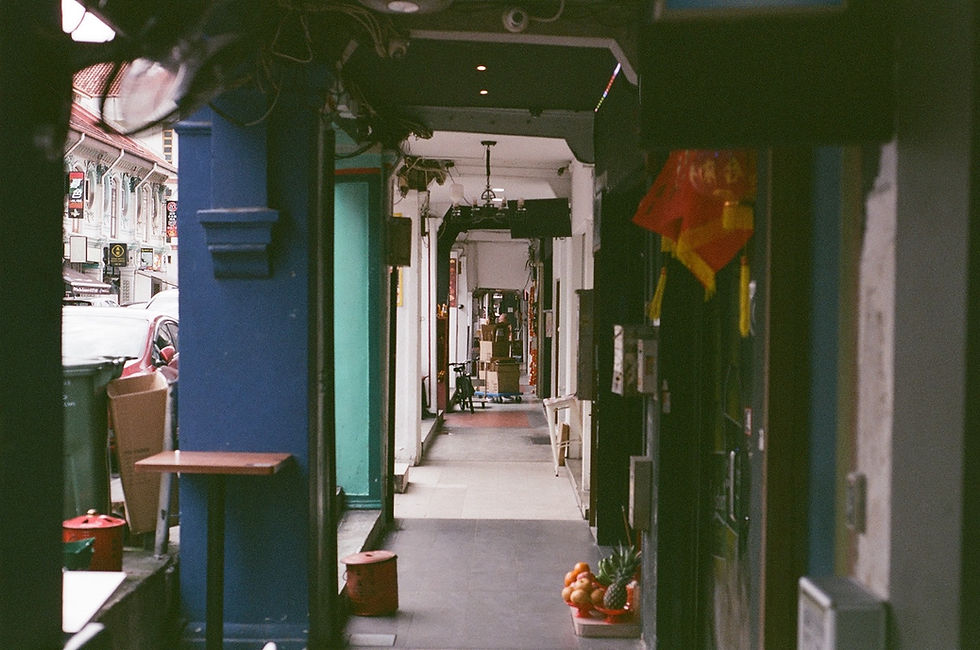Expunged areas in Singapore
- Marc Michelmann
- Aug 26
- 3 min read
Updated: Oct 8
Hock Lam Street
Hock Lam Street was indeed a beloved food haven in Singapore, renowned for its vibrant hawker stalls and delectable street food, particularly its iconic beef noodles. Located parallel to Coleman Street and High Street, with the Central Fire Station on Hill Street at its northern end, this bustling street was a staple of Singapore's culinary scene from the 1950s to the 1970s.
Hock Lam Street was a reflection of Singapore's rich cultural heritage, with its mix of Chinese, Malay, and other influences. Although the street was cleared for urban renewal in 1977 and its shophouses demolished, its legacy continues to thrive. The area is now home to Funan mall, which opened in 1985, with its name "Funan" being the hanyu pinyin version of "Hock Lam".



Source: https://www.facebook.com/photo/?fbid=122137051718910148&set=pcb.4143752009214019, 8 Oct 2025
Jalan Johore was once a well-known street in Singapore, especially prominent until the 1990s. It was lined with shophouses, back alleys, house temples, and small family businesses—and in its heyday, even had a red light district nearby. The street was a lively stretch of urban life that has since vanished from Singapore’s maps.
One of its most enduring legacies is the Boon Kee Pork Porridge stall. Starting out as a humble pushcart in the 1950s on Jalan Johor, Boon Kee’s stall has outlasted the street itself and continues to draw loyal fans. It remains one of the oldest pork porridge stalls still operating in Singapore, helmed today by second-generation owners—and yes, the queues can be quite long.
Jalan Johor is a symbol of how Singapore's urban landscape evolves. Streets that were once full of character, local commerce, and everyday stories can disappear under the pressure of redevelopment. Yet, some elements—like Boon Kee’s porridge—persist, offering a tangible thread from the past to the present.
Sources: https://www.misstamchiak.com/johor-road-boon-kee-pork-porridge/, https://mothership.sg/2017/08/johore-road-was-once-a-well-known-road-in-spore-until-it-got-erased-from-our-maps-in-the-1990s/?utm_source=chatgpt.com

Kampong Tempe was a Javanese-settled village that emerged around 1905 on the swampy slopes near what is now Sixth Avenue and Bukit Timah Road. Despite the challenging environment—infested with mosquitoes—the settlers, led by Alias bin Ali, carved out a livelihood through farming, growing staples like tapioca, chili, tobacco, and other produce.
Over time, the village grew into a tight-knit community with perhaps 100 to 200 homes, often clustered by family. It earned its name—and a touch of fame—for its homemade tempeh, a fermented soybean cake of Indonesian origin, produced by many families whose recipes passed through generations. The village life here was multicultural: alongside Malay Javanese families lived Chinese families, who ran businesses such as grocery shops and even a wayang (theatrical) stage, which became sites of cultural exchange and harmony.
As Singapore modernised, Kampong Tempe gradually faded—by the late 20th century, urban development erased much of its physical presence. Yet echoes of its past linger in landmarks such as Masjid Al‑Huda, originally built in 1925 on land donated in 1905, serving as a spiritual and communal anchor for the kampong residents. Hoon San Temple, built in 1902 nearby, similarly stood as a shared cultural touchstone among different communities. Today, these structures are part of the Bukit Timah "Kampong Life Trail," preserving snippets of kampong-era heritage amid the city’s modern fabric.
Sources: https://kampongtempeh.blogspot.com/2011/12/kampong-tempeh.html, https://epigrambookshop.sg/products/kampung-tempe, https://www.roots.gov.sg/places/places-landing/Places/landmarks/Bukit-Timah-Heritage-Trail-Kampong-Life-Trail/Masjid-Al-Huda, https://mothership.sg/2018/05/bukit-timah-history-trail-kampong-past/
Jalan Woodbridge
Jeddah Street
Roads in this vicinity were named after Arabian towns because the land was formerly the residence of two wealthy Arab merchants from Palembang; Syed Mohammed bin Harum Al Junied (d.1824) and his nephew, Syed Omar bin Ali Al Junied (1792-1852).
Known as sio poh sam pai yang teng bang in Hokkien, it means the "lane of the praying pavilion in small town". Sam pai yang is the Malay term sembaiang (prayer). The street led from Beach Road to a mosque. The name illustrates the distinction drawn by the Chinese between a Mohamedan place of worship and a temple of their own. The essence of Islam is prayer, while Chinese pay more attention to vows and acts of adoration.
The Hokkiens also referred to this steet as thih pa sat tui bin hang, meaning "lane opposite the iron market".





Comments